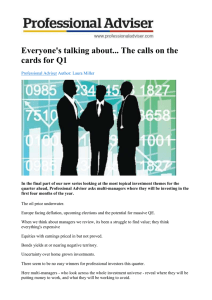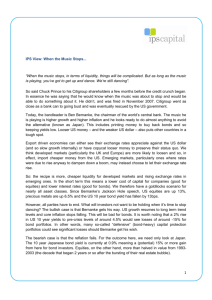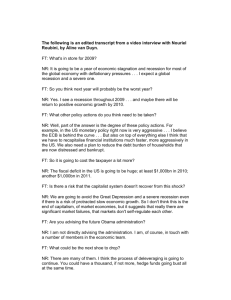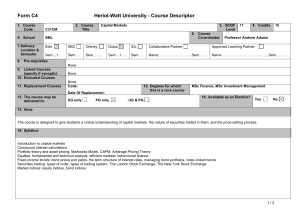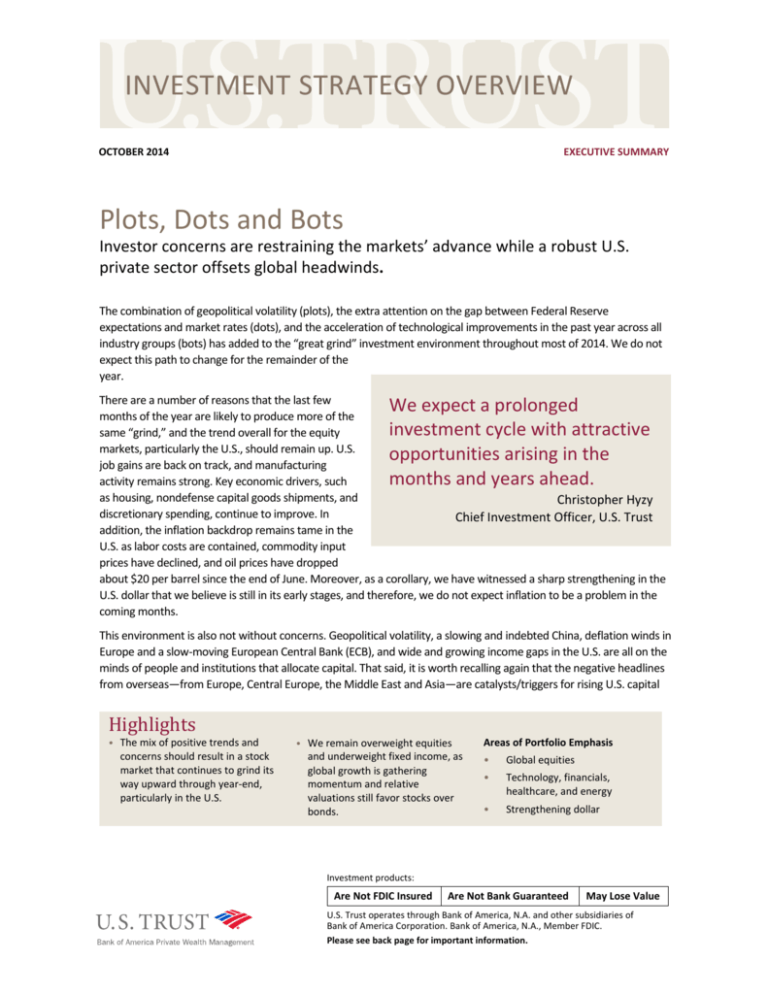
INVESTMENT STRATEGY OVERVIEW OCTOBER 2014 EXECUTIVE SUMMARY Plots, Dots and Bots
Investor concerns are restraining the markets’ advance while a robust U.S. private sector offsets global headwinds. The combination of geopolitical volatility (plots), the extra attention on the gap between Federal Reserve expectations and market rates (dots), and the acceleration of technological improvements in the past year across all industry groups (bots) has added to the “great grind” investment environment throughout most of 2014. We do not expect this path to change for the remainder of the year. There are a number of reasons that the last few We expect a prolonged months of the year are likely to produce more of the investment cycle with attractive same “grind,” and the trend overall for the equity markets, particularly the U.S., should remain up. U.S. opportunities arising in the job gains are back on track, and manufacturing months and years ahead. activity remains strong. Key economic drivers, such as housing, nondefense capital goods shipments, and Christopher Hyzy discretionary spending, continue to improve. In Chief Investment Officer, U.S. Trust addition, the inflation backdrop remains tame in the U.S. as labor costs are contained, commodity input prices have declined, and oil prices have dropped about $20 per barrel since the end of June. Moreover, as a corollary, we have witnessed a sharp strengthening in the U.S. dollar that we believe is still in its early stages, and therefore, we do not expect inflation to be a problem in the coming months. This environment is also not without concerns. Geopolitical volatility, a slowing and indebted China, deflation winds in Europe and a slow‐moving European Central Bank (ECB), and wide and growing income gaps in the U.S. are all on the minds of people and institutions that allocate capital. That said, it is worth recalling again that the negative headlines from overseas—from Europe, Central Europe, the Middle East and Asia—are catalysts/triggers for rising U.S. capital Highlights • The mix of positive trends and concerns should result in a stock market that continues to grind its way upward through year‐end, particularly in the U.S. • We remain overweight equities and underweight fixed income, as global growth is gathering momentum and relative valuations still favor stocks over bonds. Areas of Portfolio Emphasis •
Global equities •
Technology, financials, healthcare, and energy •
Strengthening dollar Investment products: Are Not FDIC Insured Are Not Bank Guaranteed May Lose Value U.S. Trust operates through Bank of America, N.A. and other subsidiaries of Bank of America Corporation. Bank of America, N.A., Member FDIC. Please see back page for important information.
inflows since the U.S. has clearly emerged as a safe harbor for investors in a sea of global tumult. When you mix the concerns with the good developments that are unfolding, you get a “grind it out” environment, in our view. DECOUPLING OF GROWTH PUTS U.S. IN CATBIRD SEAT In past reports, we have discussed why the world is still rebalancing its growth curve and this is leading to a sizable and transparent decoupling of global economic growth. The U.S. is heading into expansion mode and is likely to produce a quarter or two of growth above 4%, which is a major improvement versus last year. However, Europe is still grappling with deflationary tendencies and trying to keep growth above 0%. Japan is still reflating and moving forward on its three‐arrow strategy to ignite growth and increase inflation, but the trend has been choppy. China is trying to stop its growth slide from falling below its target of 7.5% while it transforms its economy to a more balanced growth mix of consumer spending and fixed asset investment. Moreover, the entire emerging market (EM) landscape remains a mixed bag that includes countries attempting structural reform, others battling large deficits, and still others trying to come to grips with a significantly slower trade partner in China. If the 1990s were all about the U.S. consumer carrying the world on its shoulders, then one could also argue that this cycle is characterized by the U.S. economy carrying the world on its shoulders as far as economic growth is concerned. The decoupling is not only evident in the growth rates of the various economic zones. It is also very apparent in interest rates, inflation levels, currency levels, valuation of key financial market indicators, corporate profits, and trade and budget balances, among other things. In addition, very clear private‐sector trends are developing at different levels and speeds. The U.S. is in the early stages of a manufacturing renaissance thanks to its technological advantages and high productivity versus the rest of the world, ultra‐low energy costs (the U.S. natural gas revolution), labor market restrictions and biting deflationary winds in certain corners of the world (think Europe), and a major technology advancement cycle (think the U.S.)—all of which have led to a major decoupling in the competitive position between the U.S. and the rest of the world. This competitive position is not only in manufacturing; it is also growing in energy resources, which include fossil fuels (shale oil and gas), biofuels and various renewables. And despite the concerns over healthcare costs, the technological advancement in life sciences, surgical design and procedures, and the early leadership position in cybersecurity, robotics, large‐scale 3‐D printing capabilities, mobile payment technologies, the cloud and the wireless world have all led to a growing gap between the U.S. private sector and the private sector in the rest of the world. This catbird‐seat positioning does not always lead to a leadership position in investment performance when examining the history of various asset classes because metrics like valuation and capital flows, and supply‐and‐
demand characteristics (not to mention the cost of funding sources or ease of access to liquidity) can add to or detract from the intersection of macro/micro trends and asset prices. However, we believe it does allow us to examine how large the future opportunity set is for investment, analyze the trends across the globe that are in need of financing, and determine the areas that can not only drive growth but also attract the excess capital that is circling the globe. Simply put, this business cycle is likely to run much longer than previous cycles and significantly widen the gap between the U.S. private sector and the private sectors in the rest of the world. Therefore, we expect a prolonged investment cycle with attractive opportunities arising in the months and years ahead. One widely discussed area in which the “global decoupling” is converging directly with investment trends is the currency markets. The U.S. dollar is firmly in a strengthening cycle, particularly against the Japanese yen and the euro. As the dollar moves further into this cycle, the inflation backdrop should remain muted. This should allow the Federal Reserve to remove the ultra‐accommodative monetary policy on a measured basis. The combination of economic momentum in the U.S. with measured monetary policy and low inflation is bullish for risk assets—namely, equities. Let the decoupling continue! INVESTMENT STRATEGY OVERVIEW | EXECUTIVE SUMMARY 2
PORTFOLIO CONSIDERATIONS
We expect equities to outperform fixed income: Our research firmly indicates we are in the mid‐cycle phase of the business cycle. Equities have traditionally outperformed significantly in the recovery phase and continue to outperform, albeit at a slower pace, in the mid‐cycle. We do not believe the current “growth concern” is one that becomes reality, and clearly, we are not in the late‐stage cycle, which is typically characterized by a period of rising rates and tight monetary policy. Therefore, we remain overweight equities and underweight fixed income as global growth is gathering momentum and relative valuations still favor stocks over bonds.
Within equities, and relative to other asset classes, we continue to expect U.S. equities to outperform and remain overweight: We continue to expect the U.S. economy to lead global growth and U.S. equities should outperform accordingly. Our base case is for the S&P 500 to finish 2014 in the 1,975‐to‐2,025 range and 2015 around 2,150.
We remain neutral weight emerging market equities: Valuations are attractive, and the impact from monetary policy normalization in the U.S. should fade. We remain selective in emerging markets with a preference for Mexico and South Korea, and we are committed to owning what the emerging market consumer needs and buys. Countries with large deficits will be most vulnerable to monetary normalization, especially where investors have seen little encouragement on the reform front.
We are slightly overweight international developed equities, based on our view that the improving global economic backdrop should provide enough tailwinds to support European growth, in addition to Japan continuing aggressive steps to end deflation. The ECB’s latest steps are a move in the right direction, but it is still behind the curve. As a result, we remain market weight in Europe. Given our strong dollar view, hedging international exposure, particularly in Europe and Japan, is important at this point in the cycle.
Sectors: We remain overweight financials as we expect the sector to benefit from a steep yield curve, a firming dollar, improving credit quality and stronger loan growth as the U.S. economic expansion broadens. We also retain our overweight in information technology and energy. We remain neutral weight in materials and industrials, as well as in the consumer sectors. We retain our underweights in utilities and telecommunications. We have upgraded healthcare to overweight based on its strong growth characteristics and limited negative exposure to a stronger dollar.
We remain underweight fixed income, but we still find opportunities selectively in credit: We recommend that investors reduce duration in long‐duration portfolios. Within fixed income, we continue to prefer credit over Treasuries, with an emphasis on corporate bonds, municipals, mortgage‐backed securities and commercial mortgage‐backed securities (CMBSs). Given the strength of the U.S. dollar, we are avoiding non‐North American sovereign bonds. We are maintaining our neutral weight to global high yield and leveraged loans. We also recommend a more active management approach to improve potential returns in a rising rate environment. A barbell strategy of owning bonds with both longer and shorter maturities should perform better than a laddered or bulleted strategy.
Global investment themes: We continue to emphasize Manufacturing Renaissance, Cybersecurity, Personalized Medicine, Obesity, Emerging Market Middle Class Consumer, North American Energy and Natural Resource Revolution.
We recently upgraded commodities to a neutral weight: As the global economy gains traction over the next few years, so should returns to commodity futures portfolios. Lower real yields are also supportive for commodity prices. Stronger global growth should keep industrial metals outperforming gold.
We remain slightly underweight hedge funds and neutral private equity.
We remain neutral in real estate as an asset class, as outperformance by real estate investment trusts (REITs) over the last few years has stretched valuations.
The dollar: Our macro view implies that the dollar has ended its downtrend against other major currencies and even has the potential to rise substantially against the euro and yen. Selected emerging market currencies (yuan, Korean won, and Taiwan $) are most likely to prove exceptions to a stronger greenback. INVESTMENT STRATEGY OVERVIEW | EXECUTIVE SUMMARY 3
ustrust.com This report is provided for informational purposes only and was not issued in connection with any proposed offering of securities. It was issued without regard to the specific investment objectives, financial situation or particular needs of any specific recipient and does not contain investment recommendations. Bank of America and its affiliates do not accept any liability for any direct, indirect or consequential damages or losses arising from any use of this report or its contents. The information in this report was obtained from sources believed to be accurate, but we do not guarantee that it is accurate or complete. The opinions herein are those of U.S. Trust, Bank of America Private Wealth Management, are made as of the date of this material, and are subject to change without notice. There is no guarantee the views and opinions expressed in this communication will come to pass. Other affiliates may have opinions that are different from and/or inconsistent with the opinions expressed herein and may have banking, lending and/or other commercial relationships with Bank of America and its affiliates. This publication is designed to provide general information about economics, asset classes and strategies. It is for discussion purposes only, since the availability and effectiveness of any strategy are dependent upon each individual’s facts and circumstances. Always consult with your independent attorney, tax advisor and investment manager for final recommendations and before changing or implementing any financial strategy. Other important information Past performance is no guarantee of future results. All sector and asset allocation recommendations must be considered in the context of an individual investor’s goals, time horizon and risk tolerance. Not all recommendations will be suitable for all investors. Equity securities are subject to stock market fluctuations that occur in response to economic and business developments. Investing in fixed income securities may involve certain risks, including the credit quality of individual issuers, possible prepayments, market or economic developments and yields and share price fluctuations due to changes in interest rates. When interest rates go up, bond prices typically drop, and vice versa. Tax‐exempt investing offers current tax‐exempt income, but it also involves special risks. Single‐state municipal bonds pose additional risks due to limited geographical diversification. Interest income from certain tax‐exempt bonds may be subject to certain state and local taxes and, if applicable, the alternative minimum tax. Any capital gains distributed are taxable to the investor. International investing involves special risks, including foreign taxation, currency risks, risks associated with possible differences in financial standards and other risks associated with future political and economic developments. Global investing poses special risks, including foreign taxation, currency fluctuation, risk associated with possible differences in financial standards and other monetary and political risks. Investing in emerging markets may involve greater risks than investing in more developed countries. In addition, concentration of investments in a single region may result in greater volatility. Stocks of small and mid cap companies pose special risks, including possible illiquidity and greater price volatility than stocks of larger, more established companies. For investments in ABS, MBS, and CMOs generally, when interest rates decline, prepayments accelerate beyond the initial pricing assumptions, which could cause the average life and expected maturity of the securities to shorten. Conversely, when interest rates rise, prepayments slow down beyond the initial pricing assumptions, and could cause the average life and expected maturity of the securities to extend, and the market value to decline. There are special risks associated with an investment in commodities, including market price fluctuations, regulatory changes, interest rate changes, credit risk, economic changes, and the impact of adverse political or financial factors. Nonfinancial assets, such as closely held businesses, real estate, oil, gas and mineral properties, and timber, farm and ranch land, are complex in nature and involve risks including total loss of value. Special risk considerations include natural events (for example, earthquakes or fires), complex tax considerations, and lack of liquidity. Nonfinancial assets are not suitable for all investors. Investments in real estate securities can be subject to fluctuations in the value of the underlying properties, the effect of economic conditions on real estate values, changes in interest rates, and risks related to renting properties, such as rental defaults. An investment in a hedge fund involves a substantially more complicated set of risk factors than traditional investments in stocks or bonds, including the risks of using derivatives, leverage, and short sales which can magnify potential losses or gains. Restrictions exist on the ability to redeem units in a hedge fund. Hedge funds are speculative and involve a high degree of risk. Treasury bills are less volatile than longer‐term fixed income securities and are guaranteed as to timely payment of principal and interest by the U.S. government. Dividend payments are not guaranteed. The amount of a dividend payment, if any, can vary over time. Diversification does not ensure a profit or guarantee against loss. Breakdown reflects ratings from Standard & Poor’s, Moody’s and/or Fitch Ratings. For additional information on ratings, please see www.standardandpoors.com, www.moodys.com, and/or www.fitchratings.com. This report may not be reproduced or distributed by any person for any purpose without prior written consent. © 2014 Bank of America Corporation. All rights reserved. | ARRT6YL3 | WP‐10‐14‐0475 | 10/2014 INVESTMENT STRATEGY OVERVIEW | EXECUTIVE SUMMARY 4

